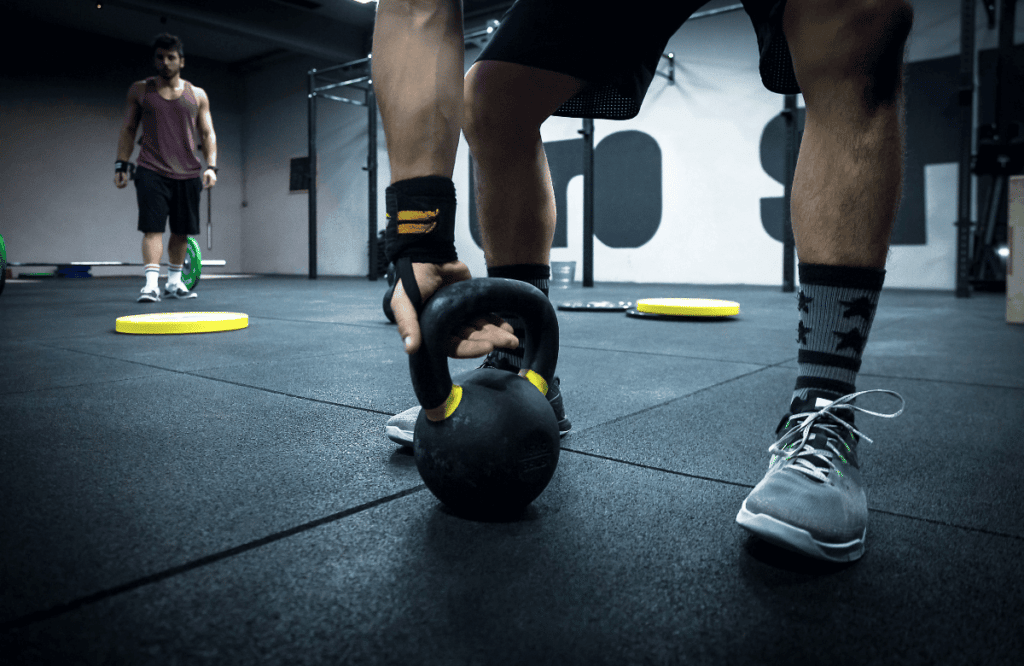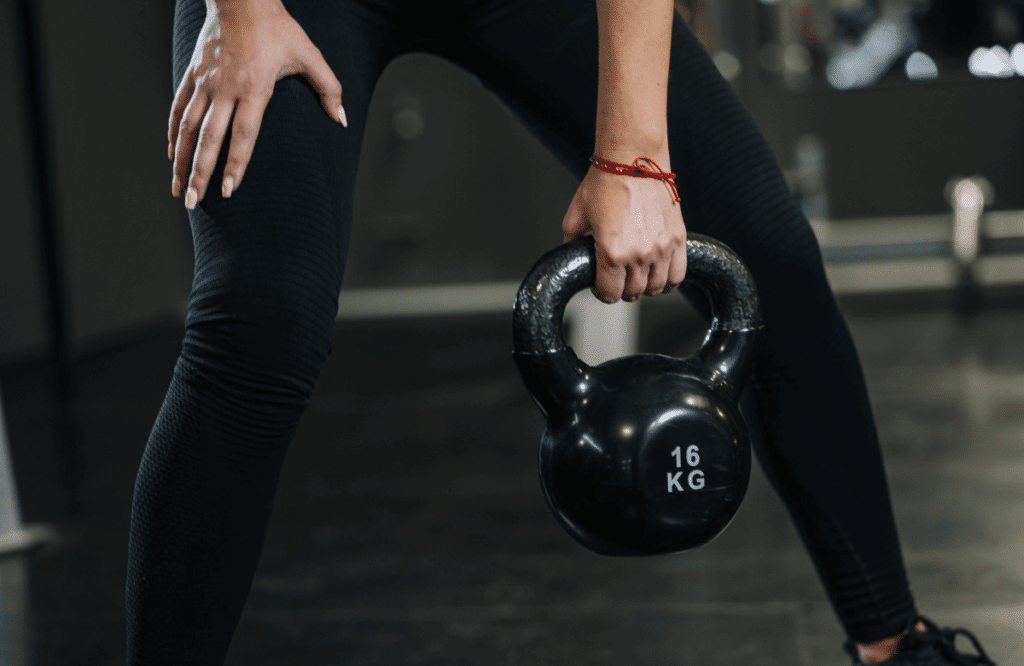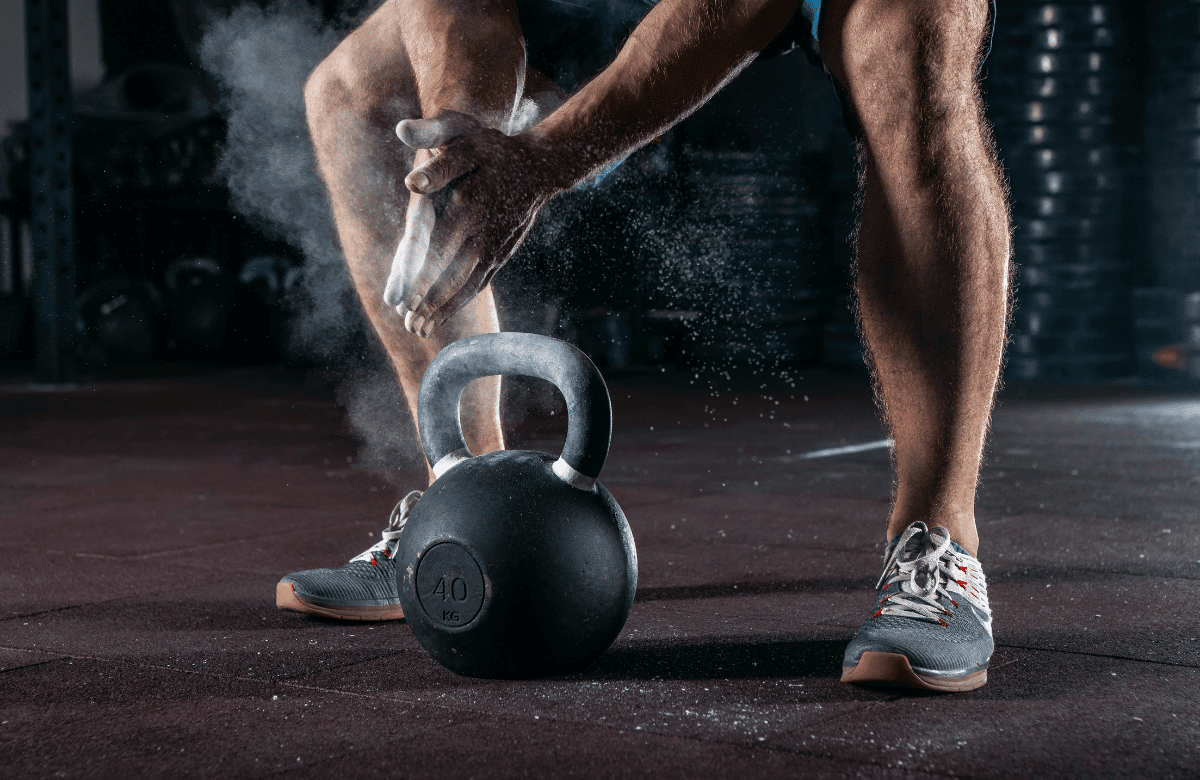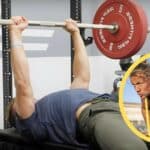Are you tired of swinging kettlebells? Are you looking for a controlled compound kettlebell exercise? If you answered yes to either of these questions—you need to try the kettlebell row.
We cover the kettlebell exercise, the perfect kettlebell row, workout ideas, and more in the article below. Read on for everything you need to know.
The kettlebell row is a pulling exercise where the lifter takes a bent-over row position and hinges forward at the hips. With the kettlebell on or near the ground, the lifter pulls the weight towards the torso to work the shoulders, back, core, hips, and legs.
Follow the detailed instructions below to perform a one-arm kettlebell row.

Jump to:
- Mistakes to Avoid
- What Muscles Does the One-Arm Kettlebell Row Work?
- Kettlebell Row Benefits
- Kettlebell Rowing Variations to Consider
- Single-Arm Kettlebell Row Seesaw Variation
- Alternating Kettlebell Row Variation
- Plank Row With Bench
- Kettlebell Lateral Row
- Are Kettlebell Rows a Good Exercise?
- Should I Use Heavy Weights With Rows?
- Which Row is the Most Effective?
- Are Kettlebell Rows a Good Exercise?
- Should I Use Heavy Weights With Rows?
- Which Row is the Most Effective?
Step 1: Take a Staggered Stance With Feet
Take your kettlebell and place it on the floor in front of your right foot. Ensure the handle is parallel to the rest of your body.
Take a step back with your right leg. Now, hinge forward at your hips so your torso is parallel to the ground. Grip the kettlebell handle with your right hand and prepare for the movement.
Step 2: Perform the Row
With the kettlebell weight in your right hand, lift up through your elbow. Ensure your elbow is tucked toward your side until your hand meets the ribcage.
Keep the core muscles tight and your back straight during the lift.
At the top of the lift, tighten the lats and hold for a moment. Afterward, lower the weight back down until the arm is fully extended. This will complete one repetition.
Now you can finish your desired number of reps and switch sides to repeat.

Mistakes to Avoid
Although the row is a reasonably straightforward movement, there are a few common pitfalls to
be aware of. Avoiding these mistakes can help you perform the exercise safely and effectively.
Too Much Weight
Like any other lift, using too much weight on a kettlebell row can increase your risk of injury and overexertion. It’s essential to use effective weight ranges that allow you to perform the exercise with optimal technique. Reduce the load if you notice your form starts to slip, and focus on technique when learning the movement.
Rounded Upper Back
Rounding in the upper back is a common mistake for any type of row, including kettlebell variations. A rounded upper back not only makes the lift less effective but can lead to injury and lower back pain. Instead, keep your chest up, and your hips pushed back. Your back should be tight and straight.
Overextended Neck
An overextended neck is another common pitfall when performing a row. Placing too much tension on the neck and spine is one of the fastest paths to injury. It’s best to keep your neck neutral when completing the movement to avoid excess tension, strain, and damage to the area.

What Muscles Does the One-Arm Kettlebell Row Work?
The kettlebell row is a compound exercise, meaning it requires multiple muscle groups at a time to perform the movement. It’s a challenging movement that’s incredibly beneficial. The kettlebell row prioritizes the lats, shoulders, arms, and back alongside other stabilization muscles.
The Lats and Back
The latissimus dorsi, or lats for short, are the primary muscle used when performing a kettlebell row. It’s the most prominent muscle in the upper body and creates a winged or V appearance in the back. Regular kettlebell bent-over rows can lead to muscle growth in the back.
The Shoulders and Arms
The kettlebell row targets several muscles in the shoulders and arms, like the deltoids, traps, rhomboids, and biceps. Some of these muscles assist the lats while pulling, while others help you lift and stabilize the weight.
Other Minor Muscles
As a full-body movement, several muscle groups are used to perform the kettlebell row. The core, hips, glutes, hamstrings, and chest muscles are all utilized during the movement. Other groups include the forearm muscles, brachialis muscles, teres muscle, and more. Activating these muscles can improve stability, mobility, and strength.

Kettlebell Row Benefits
The kettlebell row has several benefits when performed correctly. It’s a versatile compound exercise that can reduce the risk of injury, strengthen several muscle groups, and improve daily functioning.
Strengthens Major Muscle Groups
Because the kettlebell row is a compound exercise, it activates muscle groups in the upper and lower body simultaneously. You’ll strengthen muscles in the back, glutes, hamstrings, shoulders, and core all at once. Improving these muscles makes performing other movements easier and safer as well.
Reduces Risk of Injury
Kettlebell rows aren’t a very complex movement. The lower body stays in a static position while the upper body does the lifting. Although this is straightforward, it requires a lot of control and stability to perform correctly. Improving your body control will enhance your daily life and reduce the risk of injury when going about your day.
Works as a Functional Exercise
The kettlebell row works as a functional exercise to enhance daily activities like bending and reaching over. The movement improves core strength which can also benefit stability and mobility. Not to mention, the kettlebell row requires loads of calories to activate each muscle, which can help you shed calories and improve overall well-being in the process.
Kettlebell Rowing Variations to Consider
There are several kettlebell rowing variations you can utilize to target different muscle groups and change the difficulty of the movement. Here are a few to keep in mind when programming your next gym day.
Single-Arm Kettlebell Row Seesaw Variation
The seesaw variation of the single-arm kettlebell row is ideal for enhancing stabilization muscles. This method is also suitable for lightweight. The movement works similar muscles to the standard single-arm kettlebell row, but it adds a “seesaw” movement to the arm that isn’t holding the kettlebell. The other movement activates more core stabilizer muscles and burns additional calories.
Alternating Kettlebell Row Variation
The alternating kettlebell row is more dynamic and improves strength, balance, reaction time, and coordination. Instead of completing one rep at a time, you pass the kettlebell mid-air from one hand to the other. The additional movement gives you a chance to improve your mind-muscle connection and adds variety to the routine.
Plank Row With Bench
The kettlebell row plank variation will target the lower back and core muscles via plank position. You’ll need a bench to perform the exercise, and you should be comfortable holding a push-up position before jumping in. You can use light kettlebells or heavier kettlebells, depending on your fitness level.
The starting position has you with one hand on a bench or raised surface. Tighten your core and pull the kettlebell towards your hips. Be sure to keep your body in a straight line, and don’t let your hips droop down. You should feel a strong pull throughout the core muscles alongside the upper and lower back.
Kettlebell Lateral Row
The lateral kettlebell row variation alters how the muscles are targeted, as you have to lift the weight across the body. This is an excellent kettlebell rowing exercise to try. The kettlebell lateral movement adds an extra range of motion that improves lat activation. Additionally, the lateral lunge position has added benefits to the hip flexors and legs.
Are Kettlebell Rows a Good Exercise?
Kettlebell rows are an excellent movement to add to your workout routine. The dynamic movement targets muscles like the back, upper body, and lower body. It can improve mobility, strength, and stability. Rows with kettlebells should be a top consideration for your programming.
Should I Use Heavy Weights With Rows?
It’s best to use the amount of weight that allows you to safely and effectively execute the movement. Be sure to lower your weight range if your back is rounding forward or your form is slipping. Focusing on technique before weight can reduce the chance of injury or strain.
Which Row is the Most Effective?
Each row variation can be effective for increasing strength and function. That being said, the bent-over kettlebell row discussed above is one of the most effective variations for targeting the back, lats, and upper body.
Are Kettlebell Rows a Good Exercise?
Kettlebell rows are an excellent movement to add to your workout routine. The dynamic movement targets muscles like the back, upper body, and lower body. It can improve mobility, strength, and stability. Rows with kettlebells should be a top consideration for your programming.
Should I Use Heavy Weights With Rows?
It’s best to use the amount of weight that allows you to safely and effectively execute the movement. Be sure to lower your weight range if your back is rounding forward or your form is slipping. Focusing on technique before weight can reduce the chance of injury or strain.
Which Row is the Most Effective?
Each row variation can be effective for increasing strength and function. That being said, the bent-over kettlebell row discussed above is one of the most effective variations for targeting the back, lats, and upper body.















